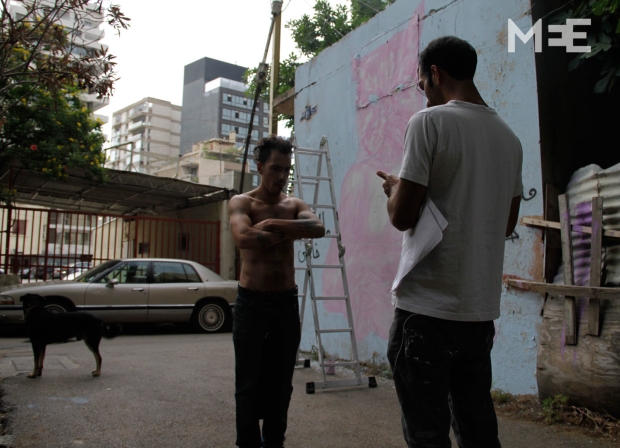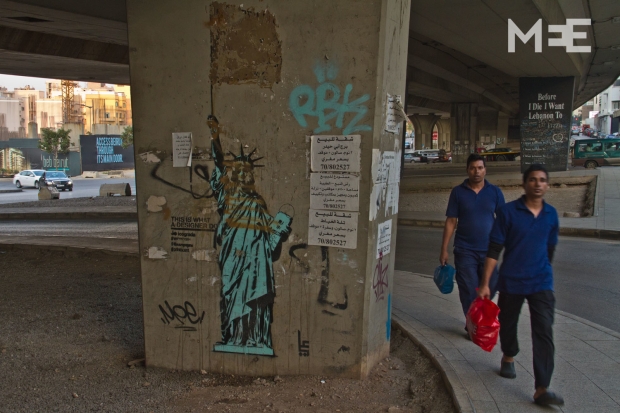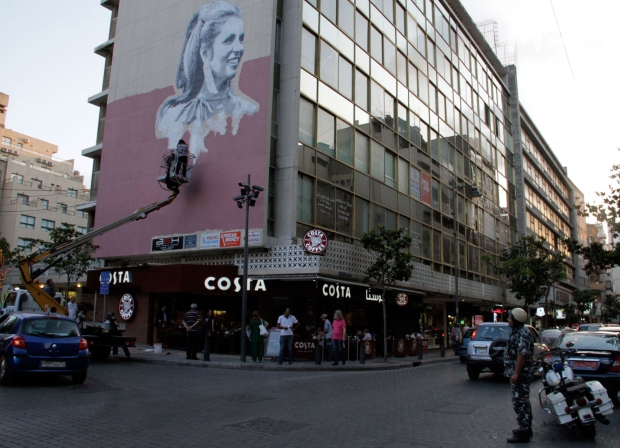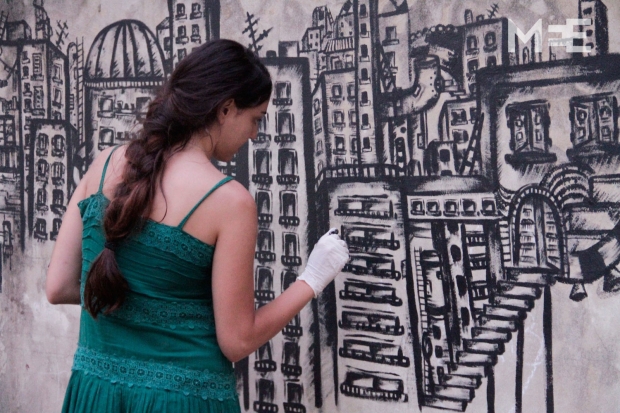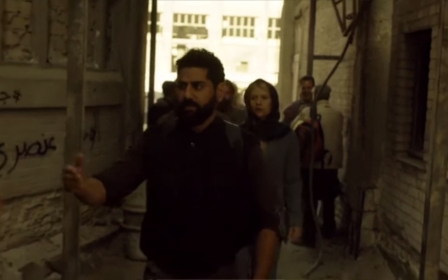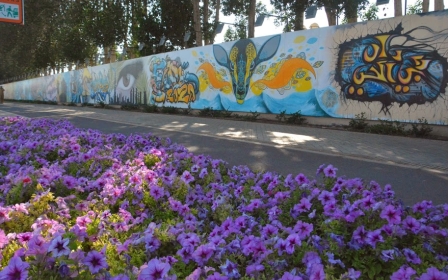Graffiti in Lebanon: Celebrating culture, breaking down divisions
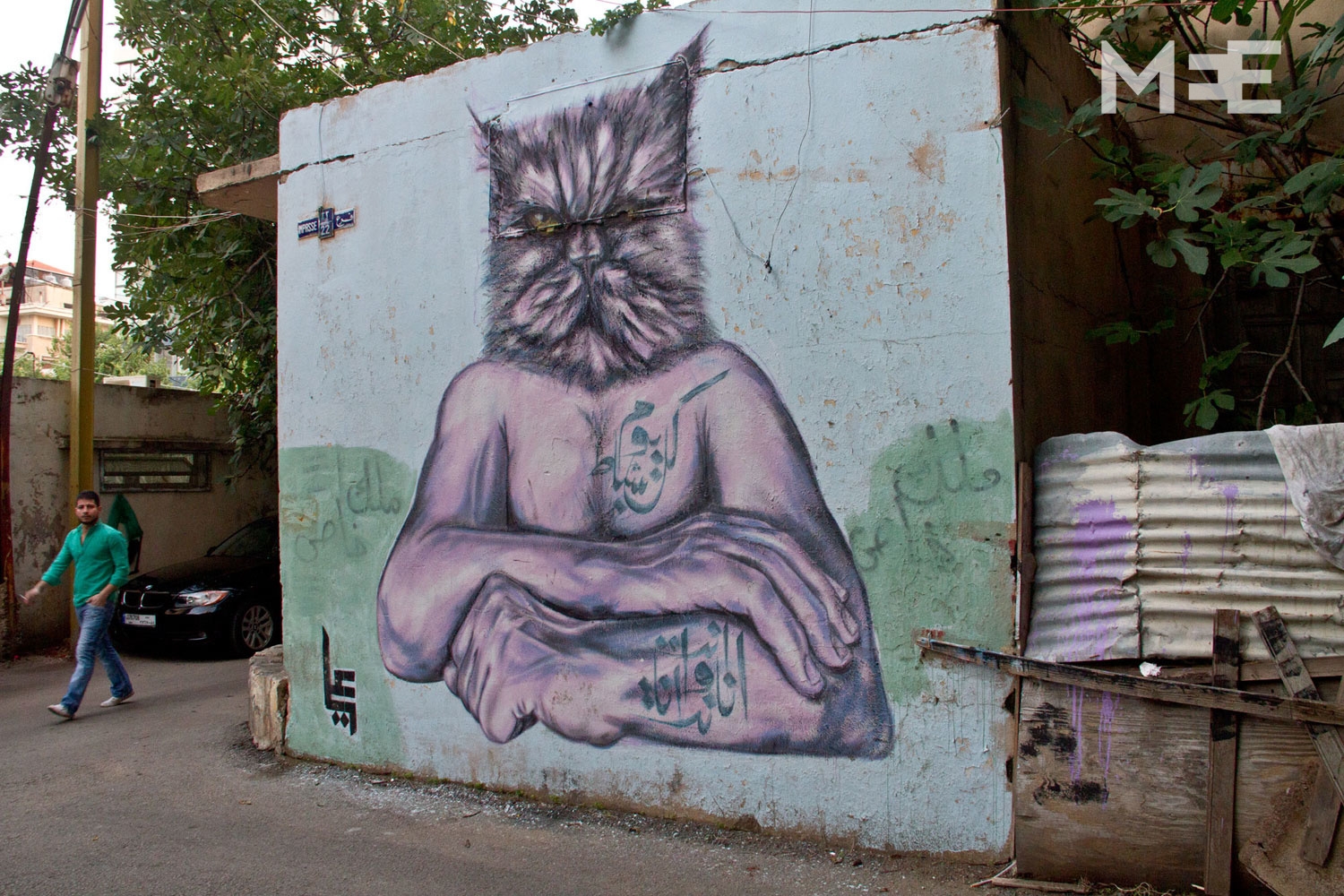
Part cat and part man. Reminiscent of the mythical Minotaur which dwelt in a labyrinth, this muscled beast resides in a narrow maze-like alley that connects the Hamra Street to Bliss Street in the heart of the Lebanese capital Beirut.
The cat-man, with crossed arms, gazes at passers-by from the wall of an old mansion. Surprisingly, the mansion has survived the voracity of real-estate developers, competing to bulldoze all picturesque views of Beirut’s urban space. A timeworn Mercedes is always parked near the mansion, and not far from it, the 30-year-old graffiti artist from Tripoli, Ali Rafei, stands on a stepladder, painting the cat-man's muscles.
While Rafei is working, a well-built young man passes through the alley with a dog. The street artist climbs down the ladder, stops him and asks if he can take a photo of his arms as a model for the outline of his artwork. The young man obliges, folding his arms across his chest as Ali takes a photo from which he will continue to work later on.
Spraying graffiti or sketching street art in Beirut was not always as easy as it is today. During the 15-year civil war, the symbols of fighting factions mirrored the real war on the streets. Each group painted its party’s symbols, plastered signs and wrote slogans on the walls of each newly gained neighbourhood territory.
Now, 25 years after the end of the civil war, the warring factions are not battling as visibly as during the conflict. However, with the omnipresent signs and symbols of parties and posters of fallen members emblazoned across walls and fences, it is easy to figure out which party still controls which particular neighbourhood of Beirut.
New generation
Today a new generation of artists is adding a fresh perspective to Beirut’s public spaces. For these street artists, graffiti is an objection to Lebanon’s sectarian political system, and a direct response to their homeland’s turmoil. Some of these objections are tame, while others are frank and blunt.
Ali Rafei is an active member of Lebanon’s street art scene. His works first appeared in 2010 on the streets of Tripoli. In this city of north Lebanon, which is better known for suicide attacks and deadly skirmishes between militants, he covered big walls with portraits of homeless people taken by the Manchester-based photographer, Lee Jeffries.
At that time, Rafei’s work was not yet political. “My main aim was to express the magnificence of those portrayals,” Rafei explains to Middle East Eye. “I wanted to show the aesthetic of the wrinkles of the homeless, old people.”
Rafei’s vigorous political and social criticisms of the status quo in Lebanon very quickly replaced his interest in the art of wrinkles. In 2011, he targeted Beirut’s walls and left behind some of Lebanon’s most remarkable pieces of street art in the Ras Beirut neighbourhood. However, many of his works were partly or entirely removed because they contained highly controversial messages.
For many Lebanese graffiti artists like Rafei, streets are the most inexpensive communication medium. “Expressing myself and my ideas in the streets is affordable for both my audience and I,” Rafei says. “The other reason why I work in the street is because of my objection to the mainstream art scene. I think a big chunk of what happens in that field is crap.”
During the last four years, Rafei has developed his own artistic style by blending calligraffiti, stencil and, of all things, wheat paste. The cat-man is part of his most recent project, which combines various techniques to draw half-human, half-animal figures. This street artist believes that humans and animals have several physical similarities in their characteristics.
“Let’s take the dogs as an example,” says Rafei, who last March created The Dog Man wheat paste piece in Beirut. “Dogs are famous for being loyal. And sometimes they are blindly loyal. So, what is the number of people who are like dogs? How many of them are blindly loyal and waiting for a piece of food from their masters?”
A new trend
In the middle of the night, in their luxury black SUV, the identical twins Omar and Mohamed Kabbani from West Beirut drive to the posh Ashrafieh neighbourhood in the eastern part of the city. The twins are going to plaster a huge wall with the image of the famous Lebanese singer and actress Sabah, who died in 2014.
The reason for working at night is not to hide in the darkness. It is to have a clearer view when they use a projector to depict the outlines. In Lebanon, graffiti artists do not need to hide from the police or conceal themselves when security officers appear on the street. The authorities don’t normally remove works of street art if they do not target political leaders.
The authorities even support some street artists. For instance, in February, in a bizarre incident, the municipality of Beirut apologised to the Ashekman graffiti crew after removing one of their graffiti works, and sponsored them for a new piece on the same wall.
In 2001, the Kabbani twins established their graffiti crew Ashekman, taking their name from a line of urban clothing known for charging a minimum $30 for a t-shirt. They introduce themselves as the “aftermath of the civil war in Lebanon”. While Mohamed and one assistant climb the 10-metre high scaffold to complete the image of Sabah, Ashekman’s friends arrive in SUVs and convertible cars and take photos of the twin brothers and the mural.
After they leave, Omar opens his laptop and works on a logo design for a customer. He recalls memories from the first years after the end of the civil war: “Every day on the way to school we passed by posters of martyrs and slogans on walls. That was the time when we noticed the power of graffiti.”
Just two weeks after Ashekman painted Sabah in East Beirut, another graffiti artist covered a wall in West Beirut with the image of the same singer. In June, Yazan Halwani rented a crane for one week to paint Sabah’s image on a huge wall with the help of two assistants.
Halwani is one of the pioneers of painting images of Lebanese figures on Beirut’s walls. He describes that by displaying faces of cultural figures in Beirut’s urban landscape he wants to show “how easy it is to replace the [images of] political figures with artistic works”.
At the age of 15, Halwani started to tag his name in English in his hometown. “I just wanted to be cool when I started to tag my name,” he says. “I was not even thinking about any message, or caring about the place that I left my tag.” Later, Halwani began utilising Arabic letters to decorate his work, and since 2013, he has painted images of Khalil Gibran, Samir Qasir, and Mahmoud Darwish on Beirut’s walls.
According to Halwani, with these street artworks he could praise Lebanese culture. “I want to say our culture should not be built on political or religious figures, but on our cultural figures,” he explains with a strong French accent. “It is sad to see the politicians are defining our cultural domain.”
Recently, painting the images of Lebanese cultural figures is getting trendier in Beirut, and artists from diverse social, cultural and political backgrounds choose different personalities for their artworks. In June, a portrayal of Said Akal, the Lebanese poet accused of extreme nationalism by some commentators, was painted on a wall in the Christian neighbourhood of Gemmayze.
Far from the fuss
Far from Beirut’s graffiti hotspots, Shannon Kanounji is drawing on a wall in the Karkon el-Druz neighbourhood. With a brush and black colour, she paints the surreal image of a city with high buildings, twisted roads and endless stairs. This mixed neighbourhood with middle-class Shia and Sunni residents is not of interest to well-known graffiti artists; Karakon el Druz is not a hipster district.
She does not have any assistance or a big crane to cover a huge wall. “I wanted to interact with people, specifically the children of this neighbourhood,” says the 22-year-old graphic design student. “For one week I painted a detailed work by hand, to share with the neighbours the experience of creating an art piece.”
While Kanounji paints her first piece of street artwork, kids from old buildings nearby are playing football on the empty portion of land behind her. She patiently keeps working, even when the ball hits the wall near her.
The residents of high buildings around her crane their necks out of their windows or from balconies to check out how the first mural in their district is going. From time to time some of them come down to street level to take a photo of the graffiti and chart its progress.
She steps back to look at the work from a distance and asks the people who watch her working: “Do you think it’s good?” The neighbours like the street artwork. For a break, Kanounji goes one block away to a small video-game club with some of her friends. They play for half an hour and then separate. Kanounji describes her work in a modest manner: “This is what I observe, that’s how I see Beirut.”
New MEE newsletter: Jerusalem Dispatch
Sign up to get the latest insights and analysis on Israel-Palestine, alongside Turkey Unpacked and other MEE newsletters
Middle East Eye delivers independent and unrivalled coverage and analysis of the Middle East, North Africa and beyond. To learn more about republishing this content and the associated fees, please fill out this form. More about MEE can be found here.


